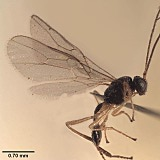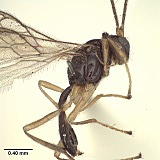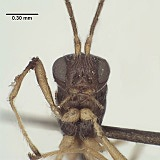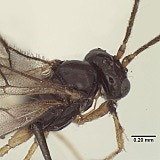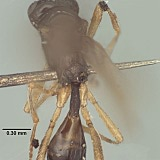Lorenzopius euryteniformis Fischer, 1963
Opius (Nosopoea) euryteniformis: Fischer 1977: 195, 206-208, key, redescription.
Lorenzopius euryteniformis: Wharton et al. (2012): 64-67 (generic transfer).
We recognize two distinct species groups within Lorenzopius: the calycomyzae species group containing the orginally included species L. calycomyzae, L. tubulatus, and L. sanlorenzensis and a second group typified by L. euryteniformis (Fischer). All have same basic wing venation and petiole. The precoxal sulcus is distinctly sculptured in the calycomyzae species group but the distinctly impressed sulcus is unsculptured or nearly so in the euryteniformis species group. The smallest specimens of the calycomyzae species group examined during this study are slightly larger than the largest available specimens of the euryteniformis species group and perhaps as a consequence they tend to have slightly longer notauli and more sculpture bordering the supra-marginal carina extending from the base of the notaulus to the tegula. Most of the species we have examined from the euryteniformis species group have reduced propodeal sculpture with the areola clearly visible.
Type locality. Costa Rica, Mount Irazu, 2200-2300 m.
There are no specimens currently determined for this OTU, or those specimens determined for this OTU are not yet mappable.
Costa Rica, Irazu,
2200-2300 m, 21-28.
V.’30 Reimoser
The holotype bears a single data label containing the information given above. However, the label data listed in the original description are as follows: “Costa Rica, La Caja bei San José, H. Schmidt”. As this species was described from a single male specimen, and the specimen from Irazu labeled as the holotype matches the original description, it is likely that the locality data in the original publication is an inadvertent error. The new species described immediately before euryteniformis in the same publication is from the La Caja locality. The type locality should therefore be Irazu (a mountain in Costa Rica), somewhere in the 2200-2300 m range in elevation.
Second label:
Opius
euryteniformis
n. sp.
det. Fischer
Third label: Holotype [purple]
Fourth label: NHMW
This material is based upon work supported by the National Science Foundation under Grant Numbers DEB 0949027.
Any opinions, findings, and conclusions or recommendations expressed in this material are those of the author(s) and do not necessarily reflect the views of the National Science Foundation.

